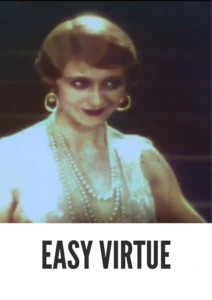Video Sources 0 Views
- Easy Virtue 1928 Colorized


Synopsis
Table of Contents
ToggleScandal and Society: Rediscover Easy Virtue (1928) Colorized

Dive into the world of scandal and high society with Alfred Hitchcock’s Easy Virtue (1928), now stunningly colorized for a modern viewing experience. This silent drama, starring Isabel Jeans, tells the compelling story of a woman haunted by her past as she navigates the complexities of love and social judgment. Perfect for classic film aficionados and digital collectors, this HD download brings a piece of Hitchcock’s early brilliance to your screen with a fresh, vibrant perspective.
Movie Storyline
Easy Virtue follows Larita Filton (Isabel Jeans), a glamorous woman with a scandalous past that continues to haunt her. After a messy divorce resulting from an impulsive act, Larita seeks refuge in France . There, she meets and marries a young, naive Englishman, John Whittaker (Robin Irvine). When she returns with him to his family estate, she faces the disapproval of his snobbish mother and the judgmental scrutiny of British high society. Larita struggles to escape her past reputation and find acceptance, leading to a dramatic confrontation and difficult choices. The film explores themes of social hypocrisy, morality, and the challenges faced by women who defy societal expectations.
The Cast of Easy Virtue
- Isabel Jeans as Larita Filton
- Franklin Dyall as Mr. Watkins
- Eric Bransby Williams as Auctioneer
- Robin Irvine as John Whittaker
- Violet Farebrother as Mrs. Whittaker
Genre and Themes
Easy Virtue is a British silent drama that delves into themes of social class, morality, and the consequences of past actions. Hitchcock uses the story to critique the hypocrisy of high society and explore the challenges faced by women who dare to defy social norms. While not a thriller, the film maintains Hitchcock’s signature suspense and dramatic flair.
Historical Context
Released in 1928, Easy Virtue is based on the play of the same name by Noël Coward . Alfred Hitchcock directed the film for Gainsborough Pictures. The movie offers a glimpse into the social attitudes and moral codes of the British upper class in the interwar period. Hitchcock’s adaptation captures the essence of Coward’s play while showcasing his developing cinematic techniques. Coward himself distanced himself from the film.
The Magic of Colorization
This colorized version of Easy Virtue enhances the visual impact of the film, bringing a new dimension to the characters, costumes, and settings. The colorization process has been carefully executed to preserve the original aesthetic while adding depth and vibrancy to the visuals. This allows contemporary audiences to connect with the film on a deeper level, experiencing the drama and emotions with greater intensity.
Technical Specifications
- Original Release: 1928
- Director: Alfred Hitchcock
- Based on the play by: Noël Coward
- Screenwriter: Eliot Stannard
- Cinematography: Baron Ventimiglia
- Production Company: Gainsborough Pictures
- Running Time: Approx. 73 minutes
- Language: Silent with English intertitles
Cast and Crew
- Director: Alfred Hitchcock
- Stars: Isabel Jeans, Franklin Dyall, Eric Bransby Williams, Robin Irvine, Violet Farebrother
- Writer: Eliot Stannard (adaptation)
- Original Play: Noël Coward
- Producer: Michael Balcon
- Music: (New score added for enhanced viewing)
Technical Details
- Download Format: MP4
- Resolution: HD (1080p)
- Compatibility: Compatible with all modern devices (smartphones, tablets, computers, smart TVs)
- File Size: [Specify file size]
- Audio: Newly composed musical score to enhance the silent film experience
FAQs
Q: Is this a digitally remastered version?
A: Yes, this edition has been digitally remastered and colorized to provide the best possible viewing experience.
Q: Can I watch this on my phone?
A: Absolutely! The HD format is compatible with all smartphones, tablets, and other mobile devices.
Q: Are subtitles available?
A: Yes, the film includes the original English intertitles, ensuring you won’t miss any of the story.
Q: What other titles does this movie have?
A: Other titles include the original play Easy Virtue by Noël Coward.
Q: How was the colorization done?
A: The colorization was meticulously done, frame by frame, using advanced digital techniques to preserve the film’s original charm while adding vibrant colors.
Q: What if I have trouble downloading or playing the movie?
A: Please contact our support team for assistance. We’re here to help!
Q: Why should I download this colorized version?
A: This version offers a unique and enhanced way to experience a classic film. The colorization brings new life to the story, making it more engaging for modern audiences while preserving its historical significance.
Download Easy Virtue (1928) Colorized in HD Today!
Experience a timeless classic like never before. Add this beautifully colorized version of Alfred Hitchcock’s Easy Virtue to your digital collection today and enjoy a piece of cinematic history with a fresh, vibrant look. Click the link below to download now!










